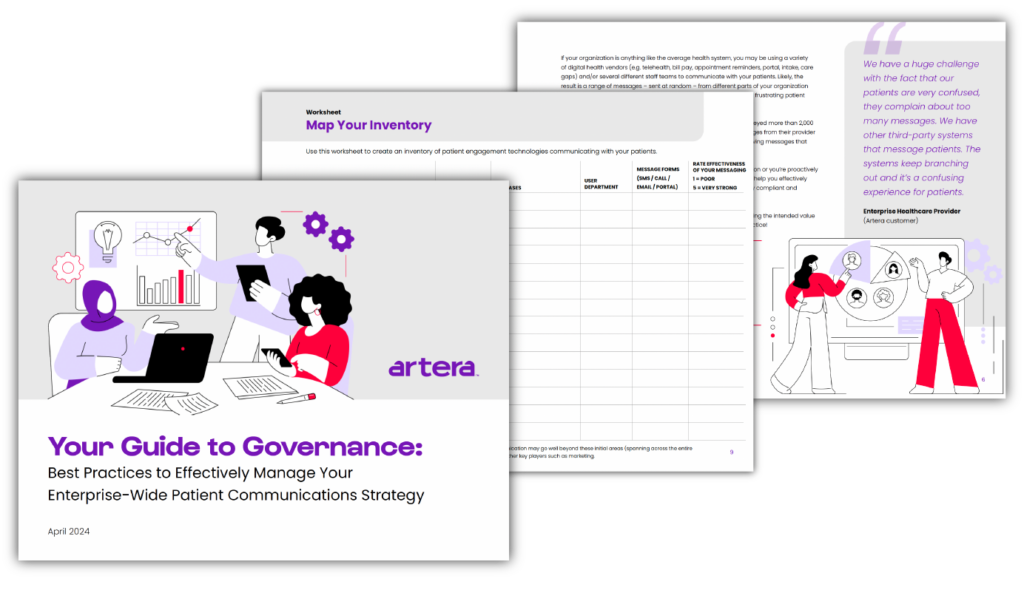The ability to craft – and manage – an effective enterprise-wide patient communications strategy is crucial as patient expectations and technological advancements continue to evolve. The journey toward optimizing this strategy begins with governance in healthcare communications, and the critical first step to doing so is identifying any challenges hindering your organization’s ability to effectively engage with patients.
Understanding the Patient Communications Landscape
Seamless, personalized communication is no longer considered noteworthy – it’s a standard. Healthcare providers today, however, often grapple with a fragmented digital infrastructure, where multiple platforms and tools are employed across the organization without a cohesive strategy. This disjointed approach leads to a common set of challenges that can compromise patient engagement and satisfaction, and often affects providers’ desired outcomes.
The Over-Messaging Conundrum
One of the most pressing challenges today? Over-communication. “There’s definitely a lot of information overload going on,” said Jon Freedman, a digital strategist with health care consulting firm Chartis, in a recent Axios piece. While this increase in communication intends to keep patients informed and engaged, patients are finding themselves inundated with texts, emails and calls, leading to digital fatigue and a reduction in adherence to their care plans.
Sarah Shillington, Chief Customer Officer at Artera, discussed this in a recent interview on “The Vibe at ViVE” with Katie Adams from MedCity News. The problem, as Shillington explains, revolves around patients receiving an excessive number of messages from various healthcare sources, leading to confusion and a decreased response rate.
To illustrate this point, Shillington shares real instances from customers where patients had negative experiences due to poorly coordinated communication efforts, such as receiving premature financial estimates for procedures before any medical consultation or being overwhelmed by a barrage of messages and surveys following a single medical appointment.
Here are just a few examples of over-messaging from various healthcare providers:
- 10+ EHR automations + several 3rd party messages simultaneously delivered via 2 different phone numbers
- One EHR delivered 72 messages within 2 hours for one appointment
- Patient received 47 instant booking automations within 1 minute for appointments scheduled in a primary care practice
The Missing Piece: Visibility, Coordination and Governance in Healthcare Communications
Many providers today lack a holistic view of their patient communication tools and outreach that span across their entire organization. So, what does this mean? Various departments within the organization may be independently managing different communication channels without awareness of others’ activities. For example, if I asked, “How many messages do your patients receive each week? each day?” or “How many different tools are communicating with your patients (via text, email, or call)?,” would you be able to answer those comfortably?
If not, you’re not alone. Many organizations today struggle with siloed operations and a lack of visibility into their holistic patient communications, which results in duplicated efforts, inconsistent messaging and a confusing patient experience. Without any coordination – or governance – among departments, significant messages may be lost or received out of order, further diluting the effectiveness of communication.
This is highlighted in our Trends in Patient Communications Report, where 68% of patients report receiving repetitive messages from their provider via various communication channels and 65% of patients report receiving messages that were sequenced “out of order.”
Additionally, JAMA Network Open research also shows that patients who receive multiple text and interactive voice response (IVR) telephone messages from health systems are more likely to opt out of future messages.
Identifying Challenges: A Structured Approach
At this point, we may have convinced you to ponder a problem that many providers are facing today: an unawareness, or lack of visibility, into their patient communications tools and outreach, leading to an overwhelming amount of messages sent to patients.
These not only reiterate the lack of visibility into an organization’s holistic patient outreach
but also emphasize just how challenging it can be to cut through the “noise” to meaningfully
engage patients and attain intended outcomes.
Take the opportunity to ponder this challenge. Have you heard directly from patients about over-communication? Do you know of all the tools and vendors reaching out to your patients?
Imagine if a patient complains that they are receiving too many communications. Your CEO comes to you and says figure out all of the communications we had with this patient…
How would you consolidate this data today?
Whether you identify this as a current challenge or are preparing for what may come through this digital surge, there is a risk that you may not be getting the intended value from your current tools and processes.
We’re here to help you effectively govern this moving forward so you can reduce patient frustration, stay compliant and optimize outcomes. Identifying the current – or existing – challenges in your patient communications strategy is just the beginning of establishing governance.
Start Your Governance Journey Today

Looking to start your governance journey?
Check out our latest resource “Your Guide to Governance“ to discover five best practices to effectively manage and optimize your enterprise-wide patient communications strategy.



